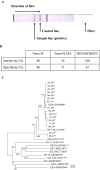Development of a Nanobody-Based Lateral Flow Immunoassay for Detection of Human Norovirus
- PMID: 27747297
- PMCID: PMC5061999
- DOI: 10.1128/mSphere.00219-16
Development of a Nanobody-Based Lateral Flow Immunoassay for Detection of Human Norovirus
Abstract
Human noroviruses are the dominant cause of outbreaks of acute gastroenteritis. These viruses are usually detected by molecular methods, including reverse transcriptase PCR (RT-PCR) and enzyme-linked immunosorbent assay (ELISA). Human noroviruses are genetically and antigenically diverse, with two main genogroups that are further subdivided into over 40 different genotypes. During the past decade, genogroup 2 genotype 4 (GII.4) has dominated in most countries, but recently, viruses belonging to GII.17 have increased in prevalence in a number of countries. A number of commercially available ELISAs and lateral flow immunoassays were found to have lower sensitivities to the GII.17 viruses, indicating that the antibodies used in these methods may not have a high level of cross-reactivity. In this study, we developed a rapid Nanobody-based lateral flow immunoassay (Nano-immunochromatography [Nano-IC]) for the detection of human norovirus in clinical specimens. The Nano-IC assay detected virions from two GII.4 norovirus clusters, which included the current dominant strain and a novel variant strain. The Nano-IC method had a sensitivity of 80% and specificity of 86% for outbreak specimens. Norovirus virus-like particles (VLPs) representing four genotypes (GII.4, GII.10, GII.12, and GII.17) could be detected by this method, demonstrating the potential in clinical screening. However, further modifications to the Nano-IC method are needed in order to improve this sensitivity, which may be achieved by the addition of other broadly reactive Nanobodies to the system. IMPORTANCE We previously identified a Nanobody (termed Nano-85) that bound to a highly conserved region on the norovirus capsid. In this study, the Nanobody was biotinylated and gold conjugated for a lateral flow immunoassay (termed Nano-IC). We showed that the Nano-IC assay was capable of detecting at least four antigenically distinct GII genotypes, including the newly emerging GII.17. In the clinical setting, the Nano-IC assay had sensitivities equivalent to other commercially available lateral flow systems. The Nano-IC method was capable of producing results in ~5 min, which makes this method useful in settings that require rapid diagnosis, such as cruise ship outbreaks and elder care facilities. The Nano-IC assay has several advantages over antibody-based IC methods: for example, Nanobodies can be readily produced in large quantities, they are generally more stable than conventional antibodies, and the Nanobody binding sites can be easily obtained by X-ray crystallography.
Keywords: Nanobody; lateral flow assay; norovirus.
Figures


References
-
- Hansman GS, Natori K, Shirato-Horikoshi H, Ogawa S, Oka T, Katayama K, Tanaka T, Miyoshi T, Sakae K, Kobayashi S, Shinohara M, Uchida K, Sakurai N, Shinozaki K, Okada M, Seto Y, Kamata K, Nagata N, Tanaka K, Miyamura T, Takeda N. 2006. Genetic and antigenic diversity among noroviruses. J Gen Virol 87:909–919. doi:10.1099/vir.0.81532-0. - DOI - PubMed
LinkOut - more resources
Full Text Sources
Other Literature Sources
Miscellaneous
